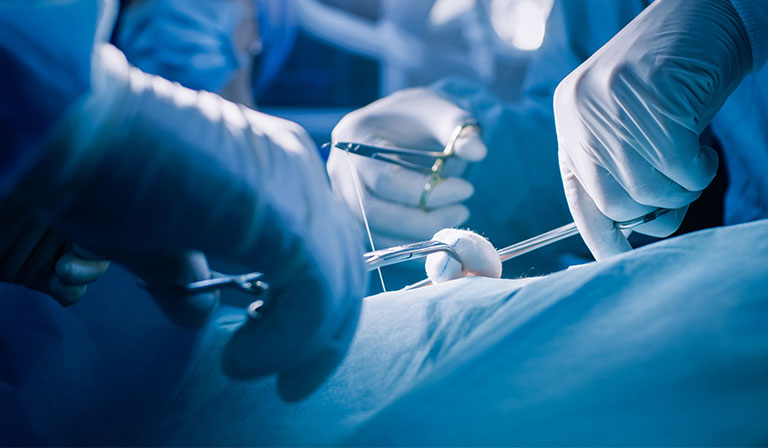

· By Colleen Horne
Different Types Of Nonabsorbable Synthetic Sutures
For surgery patients, a critical factor in a good recovery – possibly the most critical – is suturing. To minimize scarring, for infection prevention, and crucial for healing, wounds or incisions must be properly sutured. Why do doctors suture? It brings together soft tissues. Until they can heal (join) adequately, it keeps them in place. There are two main categories of sutures: Non Absorbable synthetic sutures and absorbable.
Their names are pretty self-explanatory. Your body will not absorb the nonabsorbable sutures. But, making suture removal unnecessary, your body will absorb absorbable sutures. They are left in place indefinitely when used deep within the body. If used to close incisions in the skin, however, they can be removed. Nonabsorbent sutures come in a selection of materials usually consisting of the following:
- Courlene or polyethylene
- Prolene or polypropylene
- Nylon or polyamide
- Stainless steel wire
- Silk
- Cotton
- Linen
Let's take a look at the pros and cons of various kinds of nonabsorbable sutures.
Courlene or Polyethylene
These are non-abrasive, flexible sutures that are gentle on gloves and tissues because they have a silk-like texture. Cardiovascular surgeons and orthopedic clinicians prefer this material due to its knot properties which include the following:
- Superior knot break strength
- Smooth tiedown and precise placement due to a low knot profile
- During the tying process, tighter knot security
Prolene or Polypropylene
Gradual absorption does not occur, so for long-term dental support, this is the suture of choice. Crosshatching is less likely compared to other types of sutures because this accommodates tissue swelling. The suture will remain loose as the wounds heal, however. Knot security is poor since this material is stiff and has a high memory. To fuse knots, clinicians frequently use thermocautery.
Nylon or Polyamide
As non-absorbable sutures go, nylon sutures are the most frequently used. Due to its low tissue reactivity, it is commonly used as a percutaneous suture. It's perfect for the following:
- Neurological procedures
- Ophthalmic procedures
- Cardiovascular procedures
- And various other kinds of soft tissue approximation or litigation
Over time, when buried in tissue, it loses its high tensile strength. For about 11 years, approximately one-third of their original strength can be maintained by monofilament forms. After being in tissue for about six months, it retains no tensile strength when used as a multi-filament.
Handling and tying can be difficult because nylon is stiff. Better handling properties are present, however, with multi-filament forms.
Stainless Steel Wire
Most commonly, stainless steel wire sutures are used for the following:
- Orthopedic procedures
- Sternal closure
- Hernia repair
- Abdominal wound closure
The fact that they don't promote infection is possibly their most significant advantage. Using stainless steel, even infected tissues can be repaired.
It has other advantages as well, including the following:
- Excellent knot security
- Optimum flexibility and strength
- For most patients, it's hypoallergenic
- It's inexpensive
Silk
Used since the 1890s, the standards for all other sutures were basically set by the advantages offered by silk suturing. In patients, it's unlikely to cause an allergic reaction, it has excellent knot tying properties, and it's easy to handle. After about two years, silk sutures will degrade, though they are classified as non-absorbable. It is gentle on delicate tissues and comfortable for patients due to its soft structure. Unfortunately, it can be painful and difficult to remove because the silk tends to infiltrate with cells. To limit this problem, you can purchase it coated with specialty wax or silicone.
Another downside is that under high tension, silk tends to break because it has low tensile strength. Frequently, it's used to close intertriginous areas or suture mucosal tissues. As a temporary suture during surgery, it's very helpful because it is easily handled.
Linen
Twisted linen sutures offer a unique property. In a moist environment, it can increase in strength. Over a 6-to-9-month period, however, they can lose approximately 50% of their strength. Generally speaking, they have high tensile strength and are easy to work with.
If for an extended period, tissue support is unnecessary, they are most useful for these types of procedures including the following:
- General ligatures
- Obstetrics
- Gynecology
- Gastrointestinal
- General surgery
Unfortunately, there are a couple of problems:
- They may promote infection because they are of high capillarity
- High tissue reaction may be caused by linen strands
As a result, if an infection is present, linen is not recommended.
The Best Place to Get Your Sutures and Other Medical Supplies
Your patients deserve cutting-edge equipment. Since 2011, ProNorth Medical Corporation has been at the forefront of the medical industry supplying surgical masks, isolation gowns, sutures, and PPE, as well as veterinary and dental items. If you have questions, feel free to contact us.